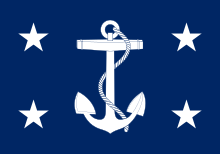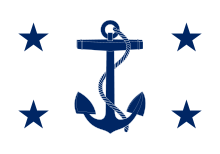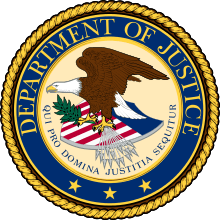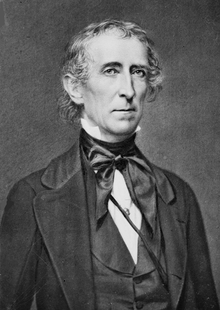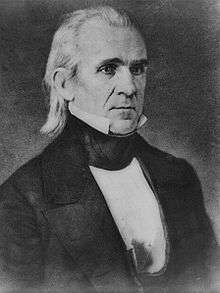John Y. Mason
| John Mason | |
|---|---|
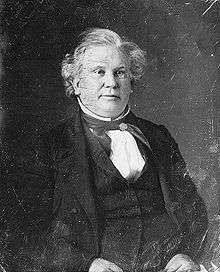 | |
| United States Minister to France | |
|
In office January 22, 1854 – October 3, 1859 | |
| President |
Franklin Pierce James Buchanan |
| Preceded by | William Cabell Rives |
| Succeeded by | Charles J. Faulkner |
| 16th and 18th United States Secretary of the Navy | |
|
In office September 10, 1846 – March 4, 1849 | |
| President | James K. Polk |
| Preceded by | George Bancroft |
| Succeeded by | William Preston |
|
In office March 26, 1844 – March 4, 1845 | |
| President | John Tyler |
| Preceded by | Thomas Gilmer |
| Succeeded by | George Bancroft |
| 18th United States Attorney General | |
|
In office March 5, 1845 – October 16, 1846 | |
| President | James K. Polk |
| Preceded by | John Nelson |
| Succeeded by | Nathan Clifford |
| Judge of the United States District Court for the Eastern District of Virginia | |
|
In office March 3, 1841 – March 23, 1844 | |
| Appointed by | Martin Van Buren |
| Preceded by | Peter Vivian Daniel |
| Succeeded by | James Dandridge Halyburton |
| Member of the U.S. House of Representatives from Virginia's 2nd district | |
|
In office March 4, 1831 – January 11, 1837 | |
| Preceded by | James Trezvant |
| Succeeded by | Francis E. Rives |
| Personal details | |
| Born |
John Young Mason April 18, 1799 Hicksford, Virginia, U.S. (now Emporia) |
| Died |
October 3, 1859 (aged 60) Paris, France |
| Resting place | Hollywood Cemetery |
| Political party |
Jacksonian (before 1833) Democratic (1833–1859) |
| Spouse(s) | Mary Fort Mason |
| Education |
University of North Carolina, Chapel Hill (BA) Litchfield Law School |
John Young Mason (April 18, 1799 – October 3, 1859) was an American politician, diplomat, and United States federal judge.
Early life, education, and career
Born in Hicksford, Greensville County, Virginia, Mason attended the University of North Carolina at Chapel Hill, where he was a member of Philanthropic Assembly. Mason graduated in 1816, and then read law at Tapping Reeve Law School in Litchfield, Connecticut, to be admitted to the Southampton County, Virginia, bar in 1819. He had a private law practice in Southampton County from 1821 to 1831.
He married Mary Ann Fort, the daughter of a prominent land-owner, in 1821 and became a planter himself, as well as continuing as a lawyer. He owned Fortsville located near Grizzard, Sussex County, Virginia.[1]
Political activities
He served in the Virginia House of Delegates from 1823 to 1827 and in the Virginia State Senate from 1827 to 1831, was a delegate to the state constitutional Convention of 1829–1830, and he served as presiding officer for the Virginia Constitutional Convention of 1850. From 1831 to 1837 served in the United States House of Representatives (the 22nd, 23rd and 24th United States Congresses), chairing the U.S. House Committee on Foreign Affairs from 1835 to 1836. During this time, he was an active supporter of most elements of Andrew Jackson's presidency, but was also a staunch advocate of states' rights. Jackson approved the appointment of George H. Thomas to the U.S. Military Academy in 1836 on his recommendation. Mason later served as a delegate to the Virginia constitutional convention of 1850.
Federal judicial service
On February 26, 1841, Mason was nominated by President Martin Van Buren to a seat on the United States District Court for the Eastern District of Virginia vacated by the elevation of Peter Vivian Daniel to the Supreme Court of the United States. Mason was confirmed by the United States Senate on March 2, 1841, and received his commission the following day. He resigned from the bench on March 23, 1844, to take a cabinet post.
Cabinet service
Mason was the U.S. Secretary of the Navy from 1844 to 1845 in President John Tyler's Cabinet and then U.S. Attorney General and then again Secretary of the Navy from 1846 to 1849, succeeding George Bancroft, under President James K. Polk.
The period of Mason's service as Navy Secretary was marked by intense Congressional pressure for economy, requiring the decommissioning of the Navy's ships of the line and making it difficult to maintain a continuous naval presence on foreign stations. The construction of floating drydocks for several Navy Yards, the simplification of the Navy's ordnance system, an expansion of the Navy's scientific endeavors and the formalization of status of the naval engineers also marked Mason's first term as Secretary.
His second term was marked by efforts to sustain the Navy's combat forces in the Gulf of Mexico and along the far-distant Pacific coast, the beginning of construction of new steamers and an effort to obtain potential warships thorough the subsidization of civilian mail steamships. The latter was an early, and ultimately unsuccessful, experiment in public-private partnership.
Electoral history
- 1831; Mason was elected to the U.S. House of Representatives with 57.88% of the vote, defeating Independent Richard Eppes.
- 1833; Mason was re-elected unopposed.
- 1835; Mason was re-elected with 72.13% of the vote, defeating Whig John Urquehart.
Later life
He was in private legal practice from 1849 to 1854 and served as president of the Virginia Constitutional Convention of 1851 and from 1853, until his death in Paris in 1859, the U.S. Minister Plenipotentiary to France. In this capacity he attracted attention by wearing at the court of Napoleon III a simple diplomatic uniform (for this he was rebuked by U.S. Secretary of State William L. Marcy, who had ordered American ministers to wear a plain civilian costume), and by joining with James Buchanan and Pierre Soulé, ministers to Great Britain and Spain respectively, in drawing up (October 1854) the historic Ostend Manifesto.
In politics he was a typical Virginian of the old school, a states rights Democrat, upholding slavery and hating abolitionism.
After his death in Paris, his remains were conveyed to the United States and interred in Hollywood Cemetery, Richmond, Virginia.
USS Mason (DD-191) from 1920 to 1940, was named in honor of Secretary of the Navy John Y. Mason.
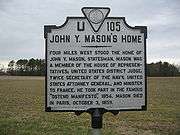
See also
References
- ↑ Virginia Historic Landmarks Commission Staff (March 1970). "National Register of Historic Places Inventory/Nomination: Fortsville" (PDF). Virginia Department of Historic Resources.

- United States Congress. "John Y. Mason (id: M000220)". Biographical Directory of the United States Congress.
- John Young Mason at the Biographical Directory of Federal Judges, a public domain publication of the Federal Judicial Center.
Further reading
External links
| Wikimedia Commons has media related to John Y. Mason. |
- United States Congress. "John Y. Mason (id: M000220)". Biographical Directory of the United States Congress.
| U.S. House of Representatives | ||
|---|---|---|
| Preceded by James Trezvant |
Member of the U.S. House of Representatives from Virginia's 2nd congressional district 1831–1837 |
Succeeded by Francis E. Rives |
| Legal offices | ||
| Preceded by Philip Pendleton Barbour |
Judge of the United States District Court for the Eastern District of Virginia 1841–1844 |
Succeeded by John Y. Mason |
| Government offices | ||
| Preceded by Thomas W. Gilmer |
United States Secretary of the Navy 1844–1845 |
Succeeded by George Bancroft |
| Preceded by George Bancroft |
United States Secretary of the Navy 1846–1849 |
Succeeded by William B. Preston |
| Legal offices | ||
| Preceded by John Nelson |
U.S. Attorney General Served under: James K. Polk 1845–1846 |
Succeeded by Nathan Clifford |
| Diplomatic posts | ||
| Preceded by William C. Rives |
United States Minister to France 1853–1859 |
Succeeded by Charles J. Faulkner |
